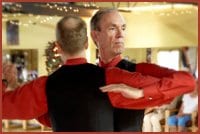When Paul Lafleur thinks of gay athletics, it’s not hockey or volleyball that first comes to mind. His sport is dance sport, or more specifically ballroom dancing. And he’ll be competing in it in Montreal’s Outgames.
“There’s actually two sections: Latin section and ballroom,” Lafleur explains. “Ballroom is the category that we’re in, and we have to dance slow waltz, tango and quick-step. If you get better, then you would have to dance foxtrot, and if you’re really, really good, then you would have to dance Viennese Waltz, but that’s only the higher levels. If you were competing in Latin, you would have to dance jive, cha-cha and either rumba or samba in the beginning levels, and as you get better you would have to dance Paso Doble, which is like the matador with the cape.”
Who knew?
The Outgames runs competitions in International style, rather than Social or “American” style. That’s because International is more exacting. And while the Outgames mostly features same-sex pairings, there is room for opposite-sex pairings as well.
Finding a venue for same-sex dance couples to compete in is difficult — there is nothing in North America, and last year Lafleur and his partner, Blake Proudfoot, went to Utrecht in the Netherlands to compete in the EuroGames as a trial run for the Outgames.
“Because we’re not European, we had to wait until the registration closed, and if there was still room they’d accept us,” Lafleur says. “We did it, and we had a ball — no pun intended. I’ve been to straight ballroom dance competitions, and they’re wonderful and everything, but there seems to be a lot of competition between participants, but at the EuroGames everyone was wishing us well, even competitors were cheering us on, and it was so wonderful to have all this support.”
The EuroGames also opened Lafleur’s eyes a little to some of the realities of the rest of the world. “Some people came and competed from countries where if they were caught practicing, they would have been sent to jail. It was amazing to see them dance, and realized how lucky we are in Canada with human rights, and not everyone has those options.”
Given the strict rules facing dance competitors, you can’t help but wonder how a same-sex pairing is different on a technical scale. As it turns out, the different rules go beyond costuming, where men are still required to wear suit and pants, but the women have more latitude to wear what they like. The biggest difference is that in order to get more points, the couple will often switch from the lead to follow mid-dance, which is a fairly tricky manoeuvre. It’s even more complicated when dancing ballroom (rather than Latin), because in ballroom the couple is always touching, whereas in Latin they dance further apart.
“When you’re leading, your posture is quite erect and you’re basically in charge and the follow[er] must follow whatever the lead does,” Lafleur explains. “When you switch, all of a sudden you become a follow and the follow tends to sit a little to the right of the lead, so they’re kind of hooked there on the side. The posture has to change when you switch back and forth like that, but not only posture but all of a sudden you’re not leading anymore, so you have to listen to your partner and follow.”
That change requires a kind of psychological adjustment. “The problem is often the lead keeps leading even when they’re following — we call it ‘back-leading’ — and it’s a big no-no,” Lafleur says. “It’s difficult because it’s a whole other mindset.”
One outcome of switching leads is that it can make both partners better dancers. “Because we have to dance both roles, all of a sudden it becomes like walking a mile in your partner’s shoes, literally. You go ‘oh, isn’t that neat — if you don’t give me a leading shoulder, I can’t turn,’ or whatever, so the light goes on.”
Lafleur started dancing on and off since he was about 16, but got away from it in university. About 10 years ago, he wanted to get back into it, but had since come out and dancing with women didn’t seem as appealing. With no outlet available in Ottawa, he organized his own gay and lesbian dance group, which has been active for a decade.
Nearly 200 couples will compete in Montreal, most of them from outside the country. “Europeans learn to dance as soon as they can walk,” Lafleur says. “It’s a horrible disadvantage we have. But we’ll give them a run for their money!”
Lafleur and Proudfoot will be competing in the Over 40 category, but have also been allowed to compete in the Under 40 this year as well. And once Montreal is over, they fully plan on competing in next year’s EuroGames in Antwerp, Belgium.
And for those who think that ballroom is strictly for the blue-rinse crowd, Lafleur has this to say: “I challenge anyone to keep up in a jive, which is like a triple swing, or even a quick-step.”


 Why you can trust Xtra
Why you can trust Xtra


